CURATION
- from this page: by Matrix
Network Node
- Name: Scott Yanow
- City/Place: Los Angeles
- Country: United States
- Hometown: New York City
Current News
- What's Up? 2020 is my 45th year as a jazz journalist, having started at the age of 3 (well, maybe a little later). I have written 11 books thus far, over 850 liner notes, and approximately 20,000 record reviews through the years. I am a regular contributor to eight magazines (Downbeat, Jazziz, the New York City Jazz Record, the Syncopated Times, the Jazz Rag from England, Jazz Artistry Now, Jazz Monthly and the Los Angeles Jazz Scene), write liner notes, press biographies and press releases for artists and labels, and offer informational lists for sale to independent jazz musicians. I’m always open to working on new assignments, discovering new artists and hearing more great jazz.
Life & Work
-
Bio:
Age 15:
Jazz caught my ear from the time I was 15. I first heard Dixieland in the Danny Kaye movie The Five Pennies and on a daily radio show hosted by the late Benson Curtis. My very first record was The Very Best Of Al Hirt & Pete Fountain. I discovered Swing when I ran across Chuck Cecil's Swinging Years on the radio.
College:
At college, roommates thought I had a huge record collection when they saw my 25 Lps, but were dismayed to find out that it was all dixieland and swing. One day at a used record store, I ran across a $1.99 Charlie Parker LP that, among other songs, included "White Christmas." I had never heard of "Groovin’ High" or "A Night In Tunisia" but at least I had heard "White Christmas" somewhere! I played the album two or three times each day for a week. It took about five days for my ears to be opened and then I became quite anxious to learn about all eras of jazz. Within two months I was into John Coltrane's 1966 explorations with Pharoah Sanders and Miles Davis' Live/Evil, quite a jump from Pete Fountain. My desire to own and hear every jazz recording is still my goal.
Accounting Degree:
After I graduated college with an accounting degree, rather than get a real job, I became the jazz editor for Record Review, a now-legendary music magazine that lasted for 44 issues. That experience and its publisher Brian Ashley started me in the jazz writing business.
Jazz Journalist and Historian:
Since then, I have been involved in many projects. Being the Senior Editor for the 3rd edition of the All Music Guide For Jazz resulted in a countless number of my CD reviews and biographies being utilized throughout the internet including Pandora Radio. In addition to having written ten books so far (most recently The Jazz Singers) and writing for the Jazz Heritage Club, I have written several episodes for the popular jazz radio series Jim Cullum's Riverwalk - Live At The Landing.
I have written over 750 liner notes, hundreds of press biographies and press releases, and it has been said that I have reviewed more jazz recordings than anyone in history. I have contributed to virtually all of the major jazz magazines including Downbeat, Jazz Times, Jazziz, Cadence, Coda, The Mississippi Rag, Jazz Forum, Jazz News, The Jazz Report, Planet Jazz, Jazz Now and Jazz Improv. These days I write regularly for Jazz Inside, Downbeat, Jazziz, Los Angeles Jazz Scene and The Jazz Rag. In addition, I offer a variety of services for jazz and blues performers.
I have also written for several jazz festival programs. The biographies and discographies that I wrote for the Playboy Jazz Festival and the San Francisco Jazz Festival programs can be found at Festival Program Guides.
For the past 20 years Jim Cullum and his jazz band's "Live from he Landing" radio series which is nationally syndicated, has presented hundreds of programs that focus on vintage jazz with a different topic each week. I have contributed writing for their various scripts. A few of these programs include clarinetists Johnny Dodds, trumpeter Henry "Red" Allen and cornetist Red Nichols.
The "Jazz from the Movies" show focused on my book Jazz On Film. It included a lot of fine music from Jim Cullum and his guests including trumpeter Bob Barnard.
Contact Information
- Email: [email protected]
Media | Markets
- ▶ Book Purchases: http://www.scottyanow.com/MyBooks.html
- ▶ Website: http://www.scottyanow.com
- ▶ YouTube Channel: http://www.youtube.com/user/ScottYanow1
More
-
Quotes, Notes & Etc.
Bio's, CD Liner Notes, Press Releases, Reviews:
Every artist needs a great bio and an informative website. All artists need visibility which leads to more CD sales, gigs, concerts and general success. Every CD needs well-written liner notes. There is no point in putting out exciting recordings that few get to hear.
I have written over 750 liner notes and hundreds of press biographies. For liner notes or a new bio, I interview you over the phone, have the writing to you within a week, and make any updates that you would like. I also write press releases.
In addition to writing CD reviews for magazines, I also write reviews specifically for artist's websites that they can use in their press kits.
My Writing
-
Publications:
The Great Jazz Guitarists: The Ultimate Guide is my latest book. It includes entries on 342 great jazz guitarists plus shorter mentions of 219 others. It relates the interesting story of the jazz guitar, its fight to replace the banjo in the 1920s, to be audible in the '30s, and its successful battle to be accepted as an important instrument in jazz.
The Jazz Singers has full-length entries on 521 singers. In addition to the historic figures (from Marion Harris and Billie Holiday to Ella Fitzgerald and Abbey Lincoln, it covers today's jazz scene in depth with original quotes from 270 jazz vocalists. It also includes a paragraph apiece on 198 other singers of today, short mentions of 55 often-surprising performers who recorded as a jazz singer on at least on one occasion, and entries on 30 jazz vocal groups. In addition, it has my pick for the ten songs that all singers should try to avoid.
Jazz On Film is a book that was really needed. In it I review 1,400 films, documentaries, shorts, videos and DVDs, all of which have at least a brief appearance by a jazz instrumentalist or singer onscreen, not just on the soundtrack. I rate both the music and the quality of the movies, from 10 (classic) to 1 (stinks).
Jazz On Record – The First Sixty Years is over 800 pages and discusses what every key jazz performer was up to during each decade. I put some humor and trivia in the time line sections, kept the thousands of record reviews very short, and portrayed the entire jazz world during every period. Swing did not disappear in 1945, bebop was still thriving in the 1960s and 70s, and newer styles did not replace older ones. I cut off the book in 1976 when every jazz style was alive and co-existing with each other.
Jazz: A Regional Exploration discusses the history of jazz and its different styles in an unusual way, by cities and regions. From New Orleans and Chicago to Kansas City and New York, jazz had many regional styles, all of which are covered in this survey of the music's first 100 years.
The trumpet has always been my favorite instrument even though I cannot get a decent note out of that illogical horn. Trumpet Kings has biographies of 479 trumpeters from all styles and covers every soloist of importance from 1901-2001. It includes many original quotes gathered from questionnaires that I sent to all of the living trumpeters and there is a liberal amount of humor since many trumpeters are simply crazy! From Buddy Bolden to Freddie Webster, from Jack Sheldon to Dave Douglas, they are all here.
Afro-Cuban Jazz focuses on the history, current scene and legacy of Latin jazz, one of the most creative styles of music around today. I separated jazz from Cuba from that of Brazil (which could be a separate book altogether), focusing on the former. The book discusses the main innovators of each era in alphabetical order from Tito Puente and Cal Tjader to David Sanchez and Chucho Valdes and has a section called “They Also Recorded Afro-Cuban Jazz” which talks about the Latin recordings of more mainstream jazz musicians.
Since dixieland and early jazz are my first love, it was only right that I would write a book on the 1920s. Classic Jazz puts the spotlight on the 1917-33 period, from the hot soloists to the early big bands, the classic blues singers to the famous ensembles. It was a pleasure really digging into that period, and I do not think that I missed anyone of significance in my biographies or in my reviews of the era's recordings.
In Bebop, I cover both the classic bop era (1945-49) and the bop-oriented soloists who matured in later years. The most difficult part about writing this book was separating bop from cool jazz and hard bop since many musicians and singers constantly cross those boundaries. In addition to Charlie Parker, Dizzy Gillespie, Bud Powell, Fats Navarro, Thelonious Monk and their contemporaries, this book discusses the more advanced stylists of the swing era, the swing big bands’ individual reactions to bop and the many bebop recordings.
I wanted Swing to be a different type of book, not just sticking to the swing era but covering all aspects of swing music through historic essays, biographies and record reviews. It discusses swing of the 1920s, the band leaders, top soloists and singers of the Swing era (1935-46) and the top swing stylists that came to prominence after the big band era ended. In addition, it was the first mainstream book to take the Retro-Swing movement of the 1980s and ‘90s and groups such as the Royal Crown Revue and Big Bad Voodoo Daddy seriously.
The third edition of the All Music Guide To Jazz gave me the opportunity to write thousands of record reviews about everyone from Bix Beiderbecke to Cecil Taylor, Louis Armstrong to John Coltrane. With its concise biographies and historic essays, it is one of the major jazz reference books.
Duke Ellington is a beautiful photo book that has many rare shots of Ellington and his sidemen from the 1920s to the 1970s. I wrote a lengthy biographical essay that accompanies the classic shots. Ellington was such a remarkable musician (pianist, composer, arranger and band leader) and during every year of 1926-73, his orchestra ranked with the top five of the time.
In 2008, I wrote the text to a rather unusual book. The talented Dutch photographer Jaap van de Klomp traveled the world taking beautiful photos of the graves of scores of jazz immortals. The large book that resulted, Jazz Lives - Till We Shall Meet And Never Part, is a rather unique masterpiece and not downbeat in the slightest. I had the honor of writing the 180 or so biographies and, in addition to the photos of the graves, there is a photo apiece of each musician and singer in his or her prime. Published in the Netherlands by Bruna Uitgevers, this will not be an easy book to find and it is not inexpensive, but it is a gem. Look for it on the internet at www.JazzLives.nl
Clips (more may be added)
The Matrix is a small world network. Like stars coalescing into a galaxy, creators in the Matrix mathematically gravitate to proximity to all other creators in the Matrix, no matter how far apart in location, fame or society. This gravity is called "the small world phenomenon". Human society is a small world network, wherein over 8 billion human beings average 6 or fewer steps apart. Our brains contain small world networks...
![]() Wolfram MathWorld on the Small World Phenomenon
Wolfram MathWorld on the Small World Phenomenon
![]() Matemática Wolfram sobre o Fenômeno Mundo Pequeno
Matemática Wolfram sobre o Fenômeno Mundo Pequeno
"In a small world, great things are possible."

It's not which pill you take, it's which pathways you take. Pathways originating in the sprawling cultural matrix of Brazil: Indigenous, African, Sephardic and then Ashkenazic, European, Asian... Matrix Ground Zero is the Recôncavo, contouring the Bay of All Saints, earthly center of gravity for the disembarkation of enslaved human beings — and the sublimity they created — presided over by the ineffable Black Rome of Brazil: Salvador da Bahia.
("Black Rome" is an appellation per Caetano Veloso, son of the Recôncavo, via Mãe Aninha of Ilê Axé Opô Afonjá.)
"Dear Sparrow: I am thrilled to receive your email! Thank you for including me in this wonderful matrix."
—Susan Rogers: Personal recording engineer for Prince, inc. "Purple Rain", "Sign o' the Times", "Around the World in a Day"... Director of the Berklee Music Perception and Cognition Laboratory
"Thanks! It looks great!....I didn't write 'Cantaloupe Island' though...Herbie Hancock did! Great Page though, well done! best, Randy"
"We appreciate you including Kamasi in the matrix, Sparrow."
—Banch Abegaze: manager, Kamasi Washington
"This is super impressive work ! Congratulations ! Thanks for including me :)))"
—Clarice Assad: Pianist and composer with works performed by Yo Yo Ma and orchestras around the world
"Dear Sparrow, Many thanks for this – I am touched!"
—Julian Lloyd-Webber: UK's premier cellist; brother of Andrew Lloyd Webber (Evita, Jesus Christ Superstar, Cats, Phantom of the Opera...)
"Thanks, this is a brilliant idea!!"
—Alicia Svigals: World's premier klezmer violinist
Developed here in the Historic Center of Salvador da Bahia ↓ .
![]() Bule Bule (Assis Valente)
Bule Bule (Assis Valente)
"♫ The time has come for these bronzed people to show their value..."
Production: Betão Aguiar
MATRIX MODUS OPERANDI
Recommend somebody and you will appear on that person's page. Somebody recommends you and they will appear on your page.
Both pulled by the inexorable mathematical gravity of the small world phenomenon to within range of everybody inside.
And by logical extension, to within range of all humanity outside as well.
MATRIX (PARDAL)
I'm Pardal here in Brazil (that's "Sparrow" in English). The deep roots of this project are in Manhattan, where Allen Klein (managed the Beatles and The Rolling Stones) called me about royalties for the estate of Sam Cooke... where Jerry Ragovoy (co-wrote Time is On My Side, sung by the Stones; Piece of My Heart, Janis Joplin of course; and Pata Pata, sung by the great Miriam Makeba) called me looking for unpaid royalties... where I did contract and licensing for Carlinhos Brown's participation on Bahia Black with Wayne Shorter and Herbie Hancock...
...where I rescued unpaid royalties for Aretha Franklin (from Atlantic Records), Barbra Streisand (from CBS Records), Led Zeppelin, Mongo Santamaria, Gilberto Gil, Astrud Gilberto, Airto Moreira, Jim Hall, Wah Wah Watson (Melvin Ragin), Ray Barretto, Philip Glass, Clement "Sir Coxsone" Dodd for his interest in Bob Marley compositions, Cat Stevens/Yusuf Islam and others...
...where I worked with Earl "Speedo" Carroll of the Cadillacs (who went from doo-wopping as a kid on Harlem streetcorners to top of the charts to working as a janitor at P.S. 87 in Manhattan without ever losing what it was that made him special in the first place), and with Jake and Zeke Carey of The Flamingos (I Only Have Eyes for You)... stuff like that.

Yeah this is Bob's first record contract, made with Clement "Sir Coxsone" Dodd of Studio One and co-signed by his aunt because he was under 21. I took it to Black Rock to argue with CBS' lawyers about the royalties they didn't want to pay (they paid).
MATRIX MUSICAL
I built the Matrix below (I'm below left, with David Dye & Kim Junod for U.S. National Public Radio) among some of the world's most powerfully moving music, some of it made by people barely known beyond village borders. Or in the case of Sodré, his anthem A MASSA — a paean to Brazil's poor ("our pain is the pain of a timid boy, a calf stepped on...") — having blasted from every radio between the Amazon and Brazil's industrial south, before he was silenced. The Matrix started with Sodré, with João do Boi, with Roberto Mendes, with Bule Bule, with Roque Ferreira... music rooted in the sugarcane plantations of Bahia. Hence our logo (a cane cutter).
A Massa (do povo carente) / The Masses (of people in need)

-
Add to my PlaylistA Massa - Raymundo Sodré (7,093 plays)
-
Add to my PlaylistSina de Cantador - Raymundo So... (6,909 plays)
-
Add to my PlaylistMagnetismo - Raymundo Sodré ... (6,353 plays)
-
Add to my PlaylistSacando a Cana - Raymundo Sodr... (5,957 plays)
-
Add to my PlaylistMêrêrê - Raymundo Sodré (5,465 plays)
-
Add to my PlaylistJardim do Amor - Raymundo Sodr... (4,677 plays)
-
Add to my PlaylistDebaixo do Céu - Raymundo Sodr... (4,151 plays)
-
Add to my PlaylistDesejo de Amar - Raymundo Sodr... (3,861 plays)
-
Add to my PlaylistOração pra Yá Oxum - Raymundo ... (3,741 plays)
-
Add to my PlaylistYá África - Raymundo Sodré (3,509 plays)
-
Add to my PlaylistMeu Rio, Cadê o Papel - Raymun... (3,177 plays)
-
Add to my PlaylistCasa de Trois - Raymundo Sodré... (2,896 plays)
-
Add to my PlaylistMulher é Laço que Prende o Coração do Vaqueiro - R... (2,556 plays)





































































































































































































































































































































































































































































